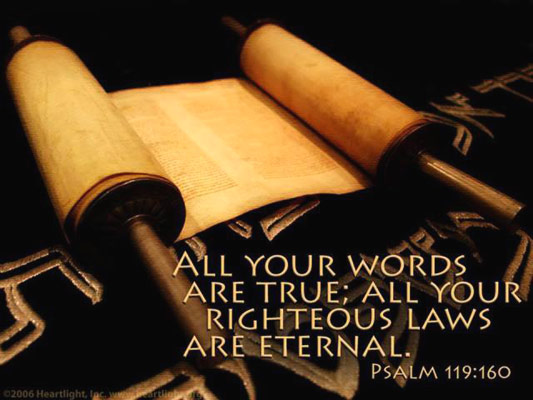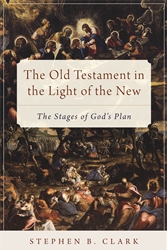.

Reading the Old and New Testaments
Together
With Christ as the Center.
by Dr. Daniel Keating
This article is excerpted from
the the Forward to the book The
Old Testament in
the Light of the
New:
The Stages of God's Plan,
copyright © 2017 by Stephen B. Clark
How are Christians
supposed to read the Old Testament? Is it still
a book that we can use? Some critics claim that
the Old Testament presents a dark view of a
violent and selfish God – and
we must leave behind these primitive myths and
stories. Other critics seek to erect an
impenetrable barrier between the Old and New
Testaments, saying that we are not justified,
historically or theologically, in reading the
Old Testament in the light of faith in Jesus
Christ.
In The Old Testament in the Light of the New,
Stephen Clark shows us how as Christians we can
(and must) read the Old Testament in the light
of the New. And of course this means that we
must read the New Testament in continuity with,
and as the fulfillment of, the Old Testament.
Christ as the center and
focal point
This focus on reading the Old and New
Testaments together with the figure of Christ as
the center and focal point is entirely in
keeping with Pope Benedict’s approach. In his
work, Jesus of Nazareth, Benedict
writes: “You can see that the Old and New
Testaments belong together. This Christological
hermeneutic, which sees Jesus Christ as the key
to the whole and learns from him how to
understand the Bible as a unity, presupposes a
prior act of faith.”1
The genius of The Old Testament in the Light
of the New is that it teaches us how to
see the narrative unity of God’s plan as
revealed in the Scriptures, Old and New
Testament. The focus is on the beginning, the
center and climax, and the end. As with a great
symphony, we only understand the individual
movements once we have heard the whole work,
once we have grasped how everything is summed up
in the final climax.
Seven stages of God's plan
So it is with the
narrative of Scripture. We need to know God’s
purpose from the beginning—and here the
opening chapters of Genesis are essential. We
need to know the center and goal of the plan
– and
this is Christ, the Word made flesh. But we also
need to know where God’s purpose is going – and
this
is eternal life
with God forever, beautifully
displayed as the “marriage feast of
the Lamb” in the book of Revelation.
The book divides the narrative of
God’s plan into seven stages: (1)
Adam and creation; (2) Noah and a
new creation; (3) Abraham and the
patriarchs; (4) Moses and the
covenant on Mt. Sinai; (5) David and
the foundation of the kingdom; (6)
the coming of Jesus Christ and the
dispensation of the Spirit; (7) the
return of Jesus Christ and the new
heavens and new earth. The author is
respectful of other ways to
distinguish the stages of God’s
plan, each of which brings out
something important. He elects to
follow these seven stages because
they show in greater detail how the
Lord God has fulfilled his plan in
discreet stages, each of which is
fulfilled in the figure of Jesus
Christ.
Importantly, Clark maintains that,
though the stages follow one upon
the other, they are also overlapping
– that
is, the Lord God may continue to
relate to people according to one
stage even as another stage is
underway. And so, even though we now
live in the stage of Christ and the
Spirit, God can continue to relate
to non-Christian Gentiles according
to the way he related to Noah and
his sons (the Noahide covenant), and
to the Jewish people according to
the covenant on Sinai (the Old
Covenant). This makes for a complex
relationship between the stages: we
are able to discern the discreet
stages but we have to be careful
about using this knowledge to make
specific judgments about the work of
God in history.
The Old Testament in the Light of
the New makes ample use of
typology in showing the
interrelation of the stages. Again,
Pope Benedict witnesses to the
indispensability of typology as an
interpretative lens to read the
unified narrative of Scripture. In Verbum
Domini, he writes: “From
apostolic times and in her living
Tradition, the Church has stressed
the unity of God’s plan in the two
Testaments through the use of
typology; this procedure is in no
way arbitrary, but is intrinsic to
the events related in the sacred
text and thus involves the whole of
Scripture.”2 Instructing
Christians about what typology is
and how it can be used to see God’s
plan in the Scripture (chapter 3) is
a priceless component of the book.
A conscious
ecumenical reading of the
Bible
Part
II provides greatly helpful
explanations on special topics and
technical issues. How historically
reliable is the Bible? How can we
interact with modern scholarship?
How does literary genre affect our
interpretation of the Bible. These
are the real questions that
readers of the Bible consistently
face. Clark has provided clear and
readable explanations of these
challenging issues.
Three qualities in particular mark
the achievement of The Old
Testament in the Light of the
New. First, it provides
(indirectly) a liturgical
reading of the Bible. In the
liturgy of the Mass and the
liturgy of the hours, the Church
adopts a typological reading of
the Bible, allowing the Old and
New Testaments to mutually
illuminate each other, with Christ
always at the center. This is
precisely the kind of approach
expounded here. Thus, this book
provides considerable help for
reading the Scripture in a way
that supports active and full
participation in the liturgy.
Second, this volume offers a
conscious ecumenical
reading of the Bible. Though the
author writes as a Catholic, he
warmly welcomes Orthodox,
Protestant, and Messianic Jewish
readers and contributors, because
he is convinced that a unified,
narrative reading of the Old and
New Testaments is something that
unites Christians and enables them
to live and worship in greater
unity.
Third, this work offers a Christ-centered
but non-supersessionist reading
of Israel, the Old Testament and
the Jewish people. The author
combines in a remarkable way a
clear and sharp focus on Christ as
the fulfillment of God’s plan
without disparaging Israel, the
place of the Law, or the ongoing
role of the Jewish people. Jesus
brings everything to fulfillment
and there is genuine newness in
him, but Israel, the Law, and the
Old Covenant retain their value
and importance. One could say that
this is a “law-friendly” and
“Israel-friendly” account of the
stages of God’s plan. Not only
does the author see Israel before
the coming of Christ in a positive
light but he believes that the
Jewish people continue to
participate in God’s ongoing plan.
In all of this, what is the final
goal of God’s plan that Clark
perceives in the entire narrative
of Scripture? It is to create a
people, sons and daughters, made
(and reformed) in God’s image and
likeness, living freely in his
presence in the world, sharing a
way of life together. The
only-begotten Son of God became
flesh and won our redemption so
that we could become through the
Spirit sons and daughters in the
Son.
Notes:
1Pope Benedict
XVI, Jesus of Nazareth,
vol. 1, From the Baptism in the
Jordan to the Transfiguration
(Doubleday: New York, 2007),
xix.
2Pope Benedict
XVI, Verbum Domini,
Post-Synodal Apostolic
Exhortation, Sept. 30, 2010, 41.
Dr. Daniel A. Keating
(Doctor of Philosophy, University of
Oxford) is professor of theology at
Sacred Heart Major Seminary in
Detroit, Michigan, USA and an elder
of The
Servants
of the Word, a lay missionary
brotherhood of men living single for
the Lord.

This article is excerpted from the the
Forward to the book The
Old Testament in the
Light of the New:
The Stages of God's Plan,
copyright © 2017 by Stephen B. Clark, and
published by Emmaus
Road Publishing, Steubenville, Ohio
USA. Used with permission.
Steve Clark
is past president of
the Sword
of the Spirit
and founder of The
Servants
of the Word.
Top image credit:
|